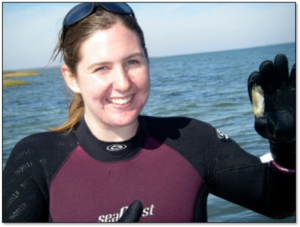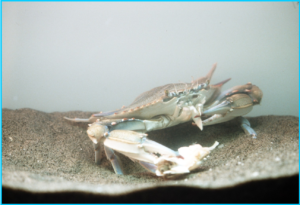A team of researchers set out to understand the decline of soft-shell and razor clams in the Chesapeake Bay that has been ongoing since the 1970s. Scientists believe the decline could be due to habitat loss, predators, disease, recruitment, and environmental changes. A team of researchers looked at all of these factors by surveying the Chesapeake Bay over three years and using historical data taken by the Smithsonian Environmental Research Center (SERC). The team included Cassandra Glaspie and Rochelle Seitz of the Virginia Institute of Marine Science (VIMS), Matthew Ogburn and Anson Hines of SERC, and Chris Dungan of the Maryland Dept. of Natural Resources.
One important result of the study, which was recently published in Marine Ecology Progress Series, was that clam populations were positively correlated with complex habitats, including sea grasses and oyster shells. They suspect these habitats provide a refuge from predators and maybe better food resources or water quality. “We’re all very excited to see the upswing of grass coverage in the Bay,” explained Seitz. “I definitely think clams can benefit from that.”

Glaspie and a razor clam in the Chesapeake.
Another notable question was about predation: the team hypothesized that clams would be negatively associated with their predators. The team found that neither the clams’ presence nor density were negatively associated with the presence of rays, blue crabs, or fish (horseshoe crabs were not abundant enough to tell). They suspect that the low predator densities and discrete seasonal sampling did not allow them to fully investigate this relationship. They think predation is an important factor in the summer, as soft-shell clam populations tend to dip then after a spring spike. However, summer declines could also be due to warming, harvest, or disease, and they did not have enough evidence from this “snapshot in time” to determine the source of the effect.
Glaspie has also led studies looking at predation more directly by using predator-exclusion cages. By excluding predators from some of the clams, she was able to get a better idea of relative predation. Mortality of clams exposed to predators was over 76% greater than caged clams, the results of this study were recently published in the journal PLOS One. Seitz also suggested using video to capture predators feeding on clams to help understand the effects of structured habitats.
The study looked extensively at infection in both clam species, focusing on dermo. They found that dermo infection rates were higher in warmer waters and at higher salinities – an expected outcome, as scientists know warmer waters stress clams and the pathogen prefers saltier water. They found that infection rates were positively correlated with clam size, but not clam density. “In the past, disease may have had an effect,” explained Seitz, “but in this study we were not able to demonstrate clear effects on soft-shell clams.” The cause for this phenomenon is not completely understood, and Dungan and other disease researchers will likely need to study the effects of dermo in the lab to clarify these results.

A blue crab eating a soft-shell clam. Photo by Rom Lipcius.
The scientists correctly hypothesized that soft-shell clam populations were negatively impacted by increasing temperatures. As the Chesapeake Bay warms due to climate change, parts of the Bay may heat enough to kill the clams, particularly in shallow waters. Soft-shell clams are already near their southern limit in Chesapeake Bay, so Seitz thinks the clams will need to move deeper to stay alive. “They will move to deeper waters within the Chesapeake Bay, but deeper waters might not have grasses or other structural protection,” she explained.
Clams do not receive the same level of recognition that oysters do in the Chesapeake. Seitz reckons that clams do not have the same importance as oysters to fisheries, and that there is less public knowledge on the species. “They do not get a fair shake, but they deserve it,” Seitz exclaimed. “In addition to being important filter feeders, they are a very important source of food for blue crabs, cownose rays, and other predators,” she added. “If there were no clams, it would force those predators to search for alternative prey items, which may put pressure on other bivalves. That could have negative impacts and a domino effect throughout the ecosystem.”
One option for sustaining clams is through aquaculture. Some aquaculture is already being conducted in Maine, and pilot studies will start as early as this summer in the Bay. Habitat restoration will ultimately be crucial to ensuring wild clams’ survival. “With enough effort applied to restoring them,”, said Seitz, “we might be able to get those populations past a threshold, and they could self-sustain with enough adults in the system that can recruit.”
